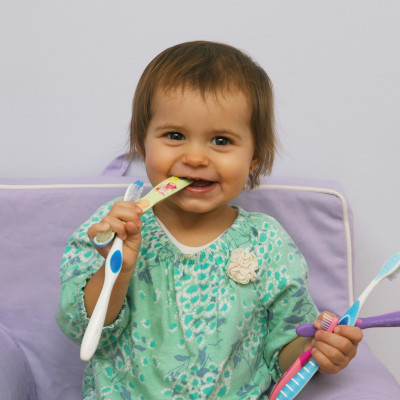How to Get Your Toddler to Brush Her Teeth
Here we go again.
Clenched, puckered lips. Head violently twisting from side to side. Flailing arms.
You’d think it was a torture device you were holding, but it’s not. It’s a pink, sparkly, princess-themed toothbrush with soft, massaging bristles meant just for your toddler’s tender gums. Yes, you’re trying to brush your little girl’s teeth, and she is resisting you every step of the way. On the rare chance that you actually get the brush in her mouth, she pushes it back out with her tongue.
You are understandably very frustrated. In your mind, you hear a voice reminding you that you’re the parent. Shouldn’t you be the one in control?
Control. That’s what this is about. Not pain, not discomfort, but control. You try to figure out who’s in charge here, and the answer is that you’re not quite sure yourself.
We’ve all been there. For most of us parents, we’ve dealt with a toddler who doesn’t want their teeth brushed. You know how important it is for them, but they’re not as easily convinced. How do you get them on board?
This subject comes up a lot during our lap exams at Neighborhood Family Dentistry. There’s no easy answer, but we do have some tips that help parents get their toddlers to brush their teeth without making it into a daily struggle.
1. Establish a routine.
Establishing a consistent, reliable routine is essential for getting your toddler to brush their teeth. Kids thrive on routine. They live in a world where they have little-to-no control over their daily activities, so they derive comfort from the consistency.
Every single day, at the same exact time, let your child know that it’s tooth brushing time. Tie it to another event if possible, like after breakfast or after bath time. If you establish a routine, you can guarantee that no matter the circumstances, you’ll be coming at your child’s mouth with that brush at the same time every day. Eventually, your babe will comply.
2. Positive reinforcement.
Reinforce good behavior with a reward and your child will likely be more willing to engage in the inconveniences of tooth brushing. The rewards don’t have to be huge: special toothbrushes, stickers, temporary tattoos or even an extra story at bedtime can do the trick.
We would recommend staying away from candy at bedtime, though. That kind of defeats the purpose.
3. Take turns.
Pre-school aged kids often look for chances to assert their independence, which is great! But when tooth brushing time comes and your child declares “I want to do it myself,” be careful – their little hands might not have the dexterity to get the job done right.
We recommend taking turns so that your child gets the chance to feel independent, but you can make sure that their teeth are taken care of. Give your little one a turn with fluoride-free training toothpaste first. Once they’ve had their fill, follow-up on your own with fluoride toothpaste, ensuring all nooks and crannies are scrubbed clean.
4. Relax.
Remember that voice that popped up into your head when your child started resisting you, telling you to take control? Don’t give in. Take a breath, stay calm and stay the course. We know full well that things can escalate very quickly when you’re dealing with a cranky two-year old, but remember: you’re the adult in the situation. Don’t let their antics get the best of you. Get in there and do the best job that you can. If it wasn’t done to your standards, just know that tomorrow is another day.

